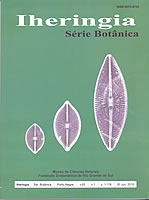(Chlorococcales lato sensu (Chlorophyceae, excl. Desmodesmus and Scenedesmus) in aquatic environments in the Coastal Plain of Rio Grande do Sul, Brazil)
Keywords:
chlorophyceans lato sensu, taxonomy, specifi c richness.Abstract
This study was carried out in isolated and interlinked lagoons, swamps, dams and in a stream of the Coastal Plain of Rio Grande do Sul, in the autumn and spring of 2003. A total of 33 specifi c and infra-specifi c taxa of Chlorococcales lato sensu were identifi ed. Among the aquatic environments, the swamps and lagoons from the Casamento Lagoon area presented the highest specifi c richness. The species occurred more frequently in the shore line than in the pelagic zone of the environments. The study showed that most of the species (59.3%) were of rare occurrence, and Monoraphidium contortum (Thur.) Kom.-Legn. was the only constant species. The taxa Ankistrodesmus densus Kors., A. stipitatus (Chod.) Kom-Legn., Coelastrum cruciatum Schmid., Kirchneriella dinae (Bohl.) Com., and Lagerheimia wratislaviensis var. bispina Hortob. are mentioned for the fi rst time in the State of Rio Grande do Sul. Descriptions, illustrations and measurements of the taxa are presented.
Downloads
References
BOHLIN, K. 1897. Die Algen der Resten Regnellschen Expedition. Bihang K. Svesnka vetenkapsakademiens handlingar, v. 7, n. 23, p. 1-47.
BOURRELLY, P. 1990. Les algues d’eau douce. Initiation à la systématique: Les Algues Vertes. Paris: Ed. Boubée. t.1, 572 p.
BUCHHEIM, M.; BUCHHEIM, J.; CARLSON, T.; BRABAND, A.; HEPPERLE, D.; KRIENITZ, L.; WOLF, M.; HEGEWALD, E. 2005. Phylogeny of the Hydrodictyaceae (Chlorophyceae): inferences from rDNA data. Journal of Phycology, v. 41, p. 1038-1054.
COMAS, A. 1996. Las Chlorococcales dulciacuícolas de Cuba. Berlin: J. Cramer. 192p. (Bibliotheca Phycologica, 99).
DEWES, J.T.; HUSZAR, V.L.M. 1986. Infl uência dos despejos lançados na sanga da Barbuda sobre as águas do lago da Barragem Santa Bárbara, Pelotas, Rio Grande do Sul, Brasil. In: Algas: a energia do amanhã. São Paulo: Instituto Oceanográfi co USP. p. 141-161.
ETTL, H.; KOMÁREK, J. 1982. Was versteht man unter dem Begriff “cocale Grünalgen”. Archiv für Hydrobiologie, v. 60 n. 4, p. 345-374. Supple.
FORTES, D.F.; TORGAN, L.C.; JÚNIOR, A.S. 2003. Composição e variação sazonal do fi toplâncton (Clorophyta-Chlorococcales) próximo à foz do Rio dos Sinos, em uma área pertencente ao Parque Estadual Delta
do Jacuí, RS, Brasil. Iheringia. Série Botânica, v. 52 n. 1, p. 103-129.
GARCIA, M.; VÉLEZ, E. 1995. Algas planctônicas da lagoa Emboaba, Planície Costeira do Rio Grande do Sul: Avaliação qualitativa. Boletim do Instituto de Biociências, n. 54, p. 75-114.
KOMÁREK, J.; FOTT, B. 1983. Chlorophyceae – Chlorococcales. In: Huber – Pestalozzi, G. Das Phytoplankton des Süsswassers. Systematik
und Biologie. Stuttgart: E. Schweizerbart’sche Verlagsbuchhandlung. Pt. 7, 1044 p. (Die Binnengewässer, v. 16).
KRIENITZ, L.; HEGEWALD, E.; HEPPERLE, D.; WOLF, M. 2003. The systematics of coccoid green algae: 18S rRNA gene sequence data versus morphology. Biologia Bratislava, v. 58, n. 4, p. 437-446.
LEWIS, L.A.; MCCOURT, R.M. 2004. Green Algae and the Origin of Land Plants. American Journal of Botany, v. 91, n. 10, p. 1535-1556.
MARCHAND, L. 1895. Synopsis et tableau Synoptique des families qui composent la Classe des Phycophités (Algues, Diatomées et Baktériens). Paris: Societé D`Etat. 20p.
NOGUEIRA, I.S. 1 991. Chlorococcales sensu lato (Chlorophyceae) do Município do Rio de Janeiro e arredores, Brasil: inventário e considerações taxonômicas. 356 p. Dissertação (Mestrado em Ciências
Biológicas – Botânica) – Universidade Federal do Rio de Janeiro, Rio de Janeiro.
PASCHER, A. 1915. Chlorophyceae II Tetrasporales, Protococcales, einzellige gattungen unscherer stellung. In: PASCHER, A. (Ed.) Die Süswasser-fl ora Deutschlands, Österreichs und der Shweiz. Jena: Gustav Fischer. v. 5, 170 p.
PHILIPOSE, M.T. 1967. Chlorococcales. Nova Delhi:Indian Council of Agricultural Research. 365 p.
PRÖSCHOLD T.; LELIAERT. F. 2007. Systematics of the green algae: Confl ict of classic and modern approaches. In: Brodie J., Lewis J.M. (Ed.). Unravelling the algae: the past, present, and future of algal systematics. London: University of Westminster. p. 123-153.
ROSA, Z.M.; MIRANDA-KIESSLICH, A.L. 1988. O Gênero Pediastrum Meyen (Chlorococcales- Hydrodictyaceae) do sistema lagunar da região do Rio Grande do Sul, Brasil. Iheringia. Série Botânica, n. 38, p. 149-169.
______. 1989. Chlorococcales (Chlorophyceae) da estação ecológica do Taim, Rio Grande do Sul, Brasil. Insula, n. 19, p. 215-228.
ROSA, Z.M.; OLIVEIRA, M.B. 1990. Chlorococcales (Chlorophyceae) de corpos d´água do Município de São Jerônimo, Rio Grande do Sul, Brasil. Iheringia. Série Botânica, n. 40, p. 89-114.
ROUND, F.E. 1983. Biologia das Algas. Rio de Janeiro: Guanabara Dois. 263 p.
SANT’ANNA, C.L. 1984. Chlorococcales (Chlorophyceae) do Estado de São Paulo, Brasil. Berlin: J. Cramer. 348p. ( Bibliotheca Phycologica, 67).
TORGAN, L.C.; ALVES DA SILVA, S.M.; WERNER, V.R.; ROSA, Z.M.; CARDOSO, L.S.; RODRIGUES, S.C.; SANTOS, C.B. dos; PALMA, C.B.; BICCA, A.B.; FORTUNA, J.R.; WEBER, A.S.; MATINS, M.D. 2007. Ficofl ora. In: BECKER, F.G.; RAMOS, R.A.; AZEVEDO, L.A. (Org.). Biodiversidade da região dos Butiazais de Tapes e da Lagoa do Casamento, Planície Costeira do Rio Grande do Sul. Brasília: Ministério do
Meio Ambiente/Porto Alegre: Fundação Zoobotânica do Rio Grande do Sul, p. 112-129.







